Évolution et Génétique
Virginie COURTIER-ORGOGOZO
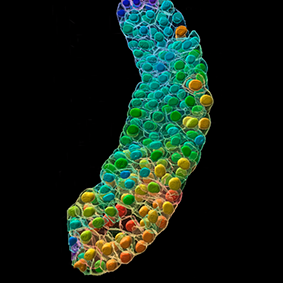
Nos recherches portent sur les mutations responsables des changements évolutifs.
Nous utilisons une combinaison de diverses approches pour identifier les mutations responsables des changements évolutifs et pour reconstruire les événements évolutifs passés. Nous espérons que notre travail fournira des données nouvelles et rigoureuses pour mieux comprendre notre évolution, passée et future.
Mots-clés : évolution, espèces, drosophile, génome, génétique, écologie, bioadhésif, développement, QTL mapping
+33 (0)1 57 27 80 43 Contact @Biol4Ever https://courtier.ijm.fr/
Notre objectif est de comprendre comment et pourquoi certains traits de caractère apparaissent au cours de l’évolution.
Nous utilisons toutes les approches disponibles (génomique, biologie du développement, biochimie, tests comportementaux, génétique, etc.) pour aborder le problème.
Evolution de la colle de drosophile (PI : V. COURTIER-ORGOGOZO)
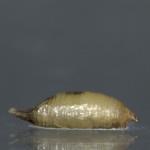 À la fin du stade larvaire, les larves de drosophile produisent une colle protéique qui permet à l’animal d’adhérer à un substrat pendant plusieurs jours au cours de la métamorphose. Nous souhaitons utiliser les puissants outils génétiques de l’organisme modèle Drosophila melanogaster pour explorer les bases moléculaires de l’adhésion à la colle des mouches. Nous voulons identifier les gènes impliqués dans l’adhésion de la colle et comprendre comment ils ont changé au cours de l’évolution pour permettre à la colle d’adhérer à divers substrats dans divers environnements. Nous avons développé un nouveau test pour quantifier l’adhésion de la colle de drosophile et nous prévoyons de mesurer l’adhésion de divers mutants et de comparer l’adhésion entre différentes populations de Drosophila melanogaster et espèces de drosophile.
À la fin du stade larvaire, les larves de drosophile produisent une colle protéique qui permet à l’animal d’adhérer à un substrat pendant plusieurs jours au cours de la métamorphose. Nous souhaitons utiliser les puissants outils génétiques de l’organisme modèle Drosophila melanogaster pour explorer les bases moléculaires de l’adhésion à la colle des mouches. Nous voulons identifier les gènes impliqués dans l’adhésion de la colle et comprendre comment ils ont changé au cours de l’évolution pour permettre à la colle d’adhérer à divers substrats dans divers environnements. Nous avons développé un nouveau test pour quantifier l’adhésion de la colle de drosophile et nous prévoyons de mesurer l’adhésion de divers mutants et de comparer l’adhésion entre différentes populations de Drosophila melanogaster et espèces de drosophile.
Evolution de l’asymétrie gauche-droite (PI: Michael LANG)
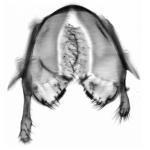
Comment des asymétries gauche-droite de taille des organes se mettent en place au cours du développement reste un mystère. Drosophila pachea a développé une asymétrie gauche-droite unique dans les lobes de ses organes génitaux. Aucune asymétrie de taille gauche-droite n’a été décrite chez D. melanogaster. Nous essayons de découvrir les mécanismes qui déterminent le développement asymétrique des lobes et le rôle de ces lobes asymétriques pendant la copulation. Nous utilisons un stock de Drosophila pachea contenant des mâles mutants symétriques spontanés et nous effectuons des ablations-laser des soies des lobes. Nous examinons également l’effet de cette asymétrie gauche-droite sur le comportement. Nous analysons des espèces proches de D. pachea afin de comprendre comment l’asymétrie gauche-droite de taille des lobes a évolué chez D. pachea.
Evolution des parties génitales (PI: V. COURTIER-ORGOGOZO)
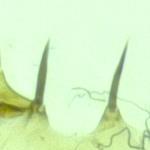 Nous souhaitons comprendre comment la morphologie des organes génitaux change rapidement au cours de l’évolution. Nous combinons des études de biologie du développement, génomique, génétique, génétique quantitative, génétique des populations, microchirurgie au laser et des expériences comportementales pour comprendre comment les gènes et les mécanismes cellulaires modulent la forme des organes de manière subtile et précise, et comment cela peut affecter la reproduction et l’évolution à long terme. Nous examinons les organes génitaux suivants : les soies hypandriales, les branches ventrales et les lobes postérieurs.
Nous souhaitons comprendre comment la morphologie des organes génitaux change rapidement au cours de l’évolution. Nous combinons des études de biologie du développement, génomique, génétique, génétique quantitative, génétique des populations, microchirurgie au laser et des expériences comportementales pour comprendre comment les gènes et les mécanismes cellulaires modulent la forme des organes de manière subtile et précise, et comment cela peut affecter la reproduction et l’évolution à long terme. Nous examinons les organes génitaux suivants : les soies hypandriales, les branches ventrales et les lobes postérieurs.
The origin of COVID-19
Cliquez ici pour plus d’informations.
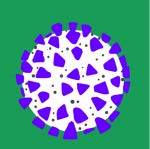
Bases de données
Gephebase contient une liste de tous les gènes et mutations qui ont été identifiés comme contribuant à des différences phénotypiques (traits morphologiques, physiologiques et comportementaux) entre populations ou espèces pour les organismes pluricellulaires.
Article associé : Courtier-Orgogozo V, Martin A, Arnoult L, Prigent S, Wiltgen S (2020) Gephebase, a Database of Genotype-Phenotype Relationships for natural and domesticated variation in Eukaryotes. Nucleic Acid Research 48(D1), D696-D703. doi:10.1093/nar/gkz796 PDF HAL
FlyPhenomics fournit une compilation des phénotypes qui ont été rapportés comme différant entre au moins deux espèces du sous-groupe D. melanogaster. Plus de 150 différences morphologiques, physiologiques et comportementales ont été décrites entre 1919 et 2006.
FlyPNS : description du système nerveux périphérique embryonnaire et larvaire de D. melanogaster. Réalisé avec Wesley Grueber.
Article associé : Orgogozo V, Grueber WB, FlyPNS, a database of the Drosophila embryonic and larval peripheral nervous system. BMC Dev Biol. 2005 Feb 17; 5(1):4.
Membres
 Wallys BIKOUMOU, Intern, COURTIER LAB
Wallys BIKOUMOU, Intern, COURTIER LAB Penelope DARNAT, Biology engineer, COURTIER LAB
Penelope DARNAT, Biology engineer, COURTIER LAB Alexis LALOUETTE, Assistant Professor, COURTIER LAB+33 (0)1 57 27 80 83, bureau 416B
Alexis LALOUETTE, Assistant Professor, COURTIER LAB+33 (0)1 57 27 80 83, bureau 416B Olga MENSHIKOVA, Intern, COURTIER LAB
Olga MENSHIKOVA, Intern, COURTIER LAB Isabelle NUEZ, Biology engineer, COURTIER LAB+33 (0)1 57 27 80 75, bureau 416B
Isabelle NUEZ, Biology engineer, COURTIER LAB+33 (0)1 57 27 80 75, bureau 416B
Pour contacter un membre de l’équipe par mail : prenom.nom@ijm.fr
Lefèvre, B. M., Delvigne, M., Camprodon, A., Vidal, J., Courtier-Orgogozo, V., & Lang, M. (2025). Evolution of a novel left-right asymmetry in organ size by co-option of a tissue rotation process. Development, dev.204662. https://doi.org/10.1242/dev.204662
Monier, M., Lorenzi, J.-N., Narasimha, S., Borne, F., Contremoulins, V., Mevel, L., Petit, R., El Hachem, Y., Graner, F., & Courtier-Orgogozo, V. (2024). Adhesive and mechanical properties of the glue produced by 25 Drosophila species. Scientific Reports, 14(1), 23249. https://doi.org/10.1038/s41598-024-74358-9
Lorenzi, J.-N., Graner, F., Courtier-Orgogozo, V., & Achaz, G. (2024). CNCA aligns small annotated genomes. BMC Bioinformatics, 25(1), 89. https://doi.org/10.1186/s12859-024-05700-1
Monier, M., Nuez, I., Borne, F., & Courtier-Orgogozo, V. (2024). Higher evolutionary dynamics of gene copy number for Drosophila glue genes located near short repeat sequences. BMC Ecology and Evolution, 24(1), 18. https://doi.org/10.1186/s12862-023-02178-y
Chai, D., Mossadeq, L. E., Raymond, M., & Courtier-Orgogozo, V. (2023). Recommended distances for physical distancing during COVID-19 pandemics reveal cultural connections between countries. PLOS ONE, 18(12), e0289998. https://doi.org/10.1371/journal.pone.0289998
Courtier-Orgogozo, V. (2023). The loci of insect phenotypic evolution. Current Opinion in Insect Science, 60, 101134. https://doi.org/10.1016/j.cois.2023.101134
Elkin, J., Martin, A., Courtier-Orgogozo, V., & Santos, M. E. (2023). Analysis of the genetic loci of pigment pattern evolution in vertebrates. Biological Reviews of the Cambridge Philosophical Society. https://doi.org/10.1111/brv.12952
Courtier-Orgogozo, V., & de Ribera, F. A. (2022). SARS-CoV-2 infection at the Huanan seafood market. Environmental Research, 214(Pt 1), 113702. https://doi.org/10.1016/j.envres.2022.113702
van Helden, J., Butler, C. D., Achaz, G., Canard, B., Casane, D., Claverie, J. M., … & Halloy, J. (2021). An appeal for an objective, open, and transparent scientific debate about the origin of SARS-CoV-2. The Lancet. Featured in several newspapers including il Fatto Quotidiano Daily Mail ThePrint
Borne, F., Prigent, S.R., Molet, M., Courtier-Orgogozo, V. (2021) Drosophila glue protects from predation. Proc. R. Soc. B. 288: 20210088. doi: 10.1098/rspb.2021.0088 DRYAD Supp Data BioRxiv
Actualité CNRS
Courtier-Orgogozo V, Danchin A, Gouyon PH, Boëte C (2020) Evaluating the Probability of CRISPR-based Gene Drive Contaminating Another Species. Evolutionary Applications 00:1–18. doi: 10.1111/eva.12939 BioRxiv PDF
Borne F, Kovalev A, Gorb S, Courtier-Orgogozo V (2020) The glue produced by Drosophila melanogaster for pupa adhesion is universal. Journal of Experimental Biology 223: jeb220608 doi: 10.1242/jeb.220608 Published 23 April 2020. DRYAD BioRxiv Featured in “inside JEB“. PDF
Passion Entomologie
Courtier-Orgogozo V, Martin A (2020) The Coding Loci of Evolution and Domestication: Current Knowledge and Implications for Bio-Inspired Genome Editing. Journal of Experimental Biology 223: jeb208934. Published 7 February 2020. doi: 10.1242/jeb.208934 PDF HAL
Courtier-Orgogozo V, Martin A, Arnoult L, Prigent S, Wiltgen S (2020) Gephebase, a Database of Genotype-Phenotype Relationships for natural and domesticated variation in Eukaryotes. Nucleic Acid Research 48(D1), D696-D703. doi:10.1093/nar/gkz796 PDF HAL BioRxiv
Publications
Preprint
Revues
Chapitre de livre
passées : Alexandre Peluffo, Flora Borne
en cours : Manon Monier
International
- Andolfatto, Columbia University, USA
- Martin, Georges Washington University, USA
- Matute, Chicago University, USA
- Santos, University of Cambridge, Cambridge, UK
- Schilthuizen, Leiden, Netherlands
- D.L. Stern, Janelia farm, Ashburn, USA
National
- Danchin, Paris
- Graner, Université Paris 7, Paris
- Montagné and T. Chertemps, Université Paris 6, Paris
- Morizot, Marseille
- Rode, Montpellier
- Wiltgen, Montpellier
- Labex “Who am I?”
- CNRS MITI 2020-2021 Adaptation du vivant
19/05/2025 : Virginie Courtier-Orgogozo, Officier dans l’Ordre National du Mérite
15.12.2023 : Epidémie: la bonne «distance de sécurité» est surtout une question de culture
28.10.2023 : De-extinction, un nouvel espoir ?
21.09.2023 : EDITO. Les indispensables de Sciences et Avenir : les mystères du vivant
L’équipe recrute :
Ingénieur / Ingénieure d’étude en biologie moléculaire et génétique de la colle de drosophile (H/F) : candidatez avant le 9 juin sur le portail CNRS emploi


